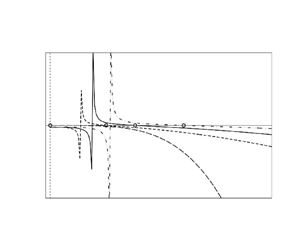Published online by Cambridge University Press: 21 December 2023

The effect of magnetic as well as electromagnetic fields on the stability of an electrically conducting viscous liquid film flowing down an inclined plane has been investigated for the full range of inclination angles  $\theta$ (
$\theta$ ( $0 < \theta \le 90^{\circ }$) in association with a given value of the Reynolds number
$0 < \theta \le 90^{\circ }$) in association with a given value of the Reynolds number  $Re$ (
$Re$ ( $0 < Re \le 100$), and vice versa. A nonlinear evolution equation is derived by using the momentum-integral method, which is valid for both small and large values of
$0 < Re \le 100$), and vice versa. A nonlinear evolution equation is derived by using the momentum-integral method, which is valid for both small and large values of  $Re$. Use of the normal mode approach on the linearized surface evolution equation gives the stability criterion and the critical value of the wavenumber
$Re$. Use of the normal mode approach on the linearized surface evolution equation gives the stability criterion and the critical value of the wavenumber  $k_c$ (for which the imaginary part of the complex frequency
$k_c$ (for which the imaginary part of the complex frequency  $\omega _i^+$ is zero) which conceive the electric parameter
$\omega _i^+$ is zero) which conceive the electric parameter  $E$, magnetic parameter
$E$, magnetic parameter  $M$, Reynolds number
$M$, Reynolds number  $Re$, Weber number
$Re$, Weber number  $We$ and inclination angle
$We$ and inclination angle  $\theta$. The nonlinear stability analysis based on the second Landau constant
$\theta$. The nonlinear stability analysis based on the second Landau constant  $J_2$ helps to demarcate all four possible distinct flow zones (explosive, supercritical, unconditional and subcritical) of this problem. A novel result of this analysis is a simple relationship between the critical values of
$J_2$ helps to demarcate all four possible distinct flow zones (explosive, supercritical, unconditional and subcritical) of this problem. A novel result of this analysis is a simple relationship between the critical values of  $k_c$ and
$k_c$ and  $k_j$ (for which
$k_j$ (for which  $J_2$ is zero) that basically gives the necessary conditions for the existence of the range of
$J_2$ is zero) that basically gives the necessary conditions for the existence of the range of  $k$ for an explosive unstable zone, which is either one or two accordingly as
$k$ for an explosive unstable zone, which is either one or two accordingly as  $k_j >k_c$ or
$k_j >k_c$ or  $k_j< k_c$, and the non-existence of an unconditional stable zone is
$k_j< k_c$, and the non-existence of an unconditional stable zone is  $k_j \le k_c$ depending upon the values of
$k_j \le k_c$ depending upon the values of  $M$. The analysis confirms the existence of two critical values of
$M$. The analysis confirms the existence of two critical values of  $M$, namely,
$M$, namely,  $M_c$ (for which
$M_c$ (for which  $k_c$ is zero) and
$k_c$ is zero) and  $M_j$ (for which
$M_j$ (for which  $k_j$ is zero). Here,
$k_j$ is zero). Here,  $M_j > M_c$ except for
$M_j > M_c$ except for  $\theta = 90^{\circ }$; and we have found the existence of all four or two (unconditional and subcritical) or one (subcritical) zone(s) of this flow problem accordingly, as
$\theta = 90^{\circ }$; and we have found the existence of all four or two (unconditional and subcritical) or one (subcritical) zone(s) of this flow problem accordingly, as  $0 \le M < M_c$ or
$0 \le M < M_c$ or  $M_c \le M < M_j$ and
$M_c \le M < M_j$ and  $M > M_j$ or
$M > M_j$ or  $M = M_j$.
$M = M_j$.